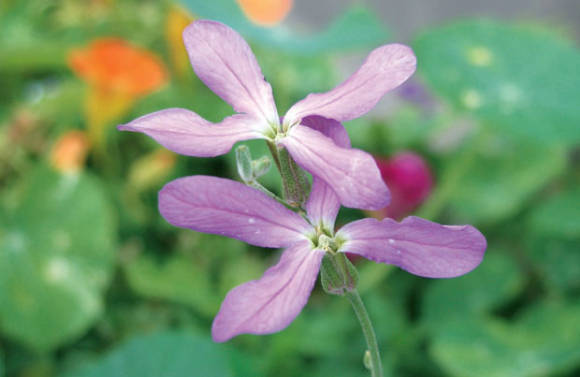Mattiola is considered to be one of the few flowers that is grown exclusively for its enchanting aroma. Not too flashy appearance and flowering only in the evening and night time are absolutely not considered its disadvantages.
After all, mattiola, as the most exquisite miracle, is still often planted separately from other flowers next to walking paths, benches, in pots on terraces and balconies, under windows that are open in summer. You can sow around spring-flowering plants, the aerial part of which dies off by summer - tulips, daffodils, etc.
Genus matthiola(Matthiola) has more than 20 species of annual and perennial herbaceous plants. Of these, the most common in floriculture is Matthiola two-horned. (Matthiola bicornis)... Within the genus, she is the closest relative of Levkoy, which is more correctly called Mattiola gray (Matthiola incana), although outwardly very little resembles him.
The plant forms highly branching bushes with straight stems 40-50 cm high, covered with modest purple, less often pinkish, lilac or white flowers about 1 cm in diameter, which are collected in racemose inflorescences. Mattiola flowers are closed during the day.

Cultivation and reproduction
Mattiola is very unpretentious. It grows on any type of soil, cold-resistant and drought-resistant, although it prefers sandy loam, limed, well-drained soil. She loves a bright location, but can tolerate light partial shade, in the shade the plant stretches and blooms reluctantly. Matthiola is cold-resistant, it can withstand frosts down to -7 ° C.
But despite its modest appearance, mattiola has long been cultivated in gardens, as its flowers have a strong and very pleasant aroma. It is felt especially well in the evening, at night and in cloudy weather, which is why this plant is called "night violet".
That is why mattiola is usually planted near terraces, gazebos, garden benches, paths. It can also be grown in mixborders, rockeries, Moorish lawns and balconies.
The most popular varieties of mattiola bicorn, most often used for planting in the country: Evening aroma and Lilac (purple), Night violet (lavender), Star color (a mixture of varieties with different shades).

Matthiola is cultivated by sowing seeds in open ground in early May, previously mixed with sand. It is not necessary to sow seeds of mattiola deeply, you can even scatter it over a moistened plot of land and sprinkle it slightly 0.5 cm from above with earth.
And in order to enjoy the wonderful and pure scent that soothes and pacifies for a longer time, you can sow Mattiola seeds a second time after 12-15 days, and a third time later. This will make it possible to extend the flowering period of the plant and saturate the garden with a fragrance, from June to October.
Growing through seedlings for Matthiola two-horned is not recommended, since its tap root system after picking and transplanting takes root very poorly. Young shoots with 2-3 leaves should be carefully thinned out to a distance of 15-20 cm. Matthiola flowering with early sowing of seeds begins in early July and lasts for a month.
Matthiola does not need special care. Watering should be done regularly, but not abundantly.
The plant does not tolerate the introduction of either fresh or sufficiently rotted manure into the soil, therefore, for top dressing, we use only mineral fertilizers for flowering plants. Dilute them in water intended for irrigation in accordance with the instructions.
4–5 dressings are carried out on nutrient soil per season, and 6–8 dressings are carried out on depleted soil. Fertilizer must be applied during the budding period, as this contributes to the formation of more flowers.
"Night violet" needs periodic weeding and regular loosening of the soil. Such procedures must be carried out very carefully so as not to damage sufficiently fragile flower stems.
The seeds collected after flowering matthiola in dry flat pods can be successfully used for sowing before winter (in November), but only on light sandy loam soil.

With proper care, Matthiola Bicornus remains healthy throughout the growing season. For the prevention of diseases, plants are not placed in areas where crops of the cruciferous family, which include the "night violet", were previously grown. Also, they are not placed where humus was previously introduced into the soil.
Attention! With regular waterlogging of the soil, root rot can occur, which often leads to the death of the plant. When any lesions appear on the leaves, diseased specimens are immediately pulled out and destroyed to prevent the spread of the infection further.
Matthiola two-horned can be affected by a fungal disease common to all cruciferous plants - keel (root disease). In this disease, the affected specimens are immediately destroyed (burned), and the soil is treated with special preparations and lime.
"Ural gardener", No. 1, 2016









